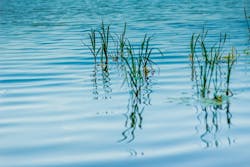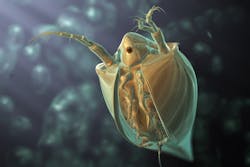WEB EXCLUSIVE: What Water Fleas Say About Your Lagoon Water Quality
About the author:
Michael Meyer is associate editor for WWD. Meyer can be reached at [email protected].
Wastewater lagoons are cost-effective treatment options that communities with the necessary available land can use to remove harmful pollutants from water before reintroducing it into the environment. There are several different types of lagoons, which are differentiated by the types of processes—if any—that are used to speed along the treatment process. Lagoons are extremely energy-efficient when compared with more managed treatment options, and they also require much less staff supervision and maintenance.
However, they do still require some attention, and paying attention to the attributes and behavior of Daphnia pulex—or “water fleas”—in lagoons can help operators understand what is going on beneath the surface.
A Flea Circus
Despite its colloquial name, Daphnia pulex is not a flea at all—it is a small crustacean closely related the shrimp that is a vital piece of aquatic ecosystems throughout the world. It consumes algae and bacteria, and is in turn consumed by fish. Because of its crucial role in these ecosystems, scientists have spent a great deal of time studying Daphnia and the ways it reacts to environmental change—in fact, it is the first crustacean to have its genome sequenced.
As such, we have a fairly thorough understanding of what happens to Daphnia when certain conditions are present in its habitat. In a wastewater lagoon, where Daphnia is safe from being consumed by fish, a population of water fleas can consume enough algae to nullify any total suspended solids problems, but doing so adversely affects the amount of dissolved oxygen in the wastewater. Daphnia, like all complex organisms, needs oxygen to live, so when it encounters hypoxic conditions, it produces hemoglobin to more efficiently transport oxygen throughout its tiny body. This causes its normally translucent body to become pink or red.
Operations personnel who observe red streaks in their lagoon water likely are seeing schools of water fleas. The fact that the Daphnia are red should tell them that the lagoon water is low in dissolved oxygen and should be treated with aeration or mixing. It also likely indicates that the water flea population in the lagoon needs to be managed, which can be achieved by introducing limited numbers of water hyacinths to the lagoon. However, if they choose this course of action, plant personnel must be sure to keep tabs on these plants as well—the water hyacinth is classified as an invasive species by the U.S. Department of Agriculture’s National Invasive Species Information Center because it can quickly form thick colonies that block sunlight from the water and prevent subsurface photosynthesis in algae and other plants that helps create oxygen, thus creating the same problem it was introduced to prevent.
A New Resource
As scientists continue to study Daphnia’s genome and map it to the organism’s behavior, they are discovering new ways its actions can help observers understand what is going on in the water in which it lives. For example, because their eggs can lie dormant for decades, scientists can compare the DNA from older embryos to those in modern populations to discover how the toxicity of the body of water has caused Daphnia to evolve. As this research continues, perhaps further telltale signs of problem water will be uncovered. For now, however, operations personnel can keep an eye on the water fleas in their lagoons to quickly gauge the oxygen content in their water—if they see red, it is time to introduce more oxygen into the environment.

